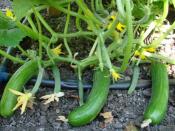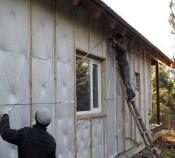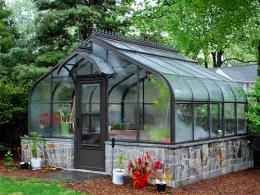Search
Login
Recommended
Greenhouse ventilation, automatic window opener for greenhouse
Gardeners with experience in maintaining a greenhouse have probably noticed that in some years it has been possible to harvest more rich crops in open ground. Although the maintenance of the greenhouse was carried out quite thorough. It turns out that the cause may be prohibitive heat.
Content
- Why you should consider the quality ventilation of the greenhouse
- How to organize proper ventilation
- Which greenhouse is better
- Greenhouse with manually open transoms
- Manually airing the greenhouse - what are its disadvantages
- Automatic ventilation of greenhouses and its advantages
- Greenhouse ventilation machine - principle of operation video
- Autonomous ventilation systems
- Ready-made window openers for greenhouses video
Why you should consider the quality ventilation of the greenhouse
In very hot weather, you can notice that the plants stop growing, new ovaries do not form on them. In the literature, one can find an explanation for this phenomenon - too high a temperature. For example, even + 30 * C for some tomatoes is undesirable - their pollen becomes sterile. When exceeding + 35 * C, ovaries on all varieties cease to form.

In the early spring, a different picture is observed - in the greenhouse, seedlings are developing quite actively, while planted in open ground is significantly behind in growth and looks very unpresentable.
The reason is again in the temperature. In an unheated greenhouse, even in cloudy weather, it will be 4-8 degrees higher during the day and 2-3 at night. It is this difference of a couple of degrees that is crucial - at a temperature of + 11 * the plant is inhibited in development, and at + 14 * it receives ideal conditions for active growth.
With the onset of hot weather, the temperature in the greenhouse in the daytime can rise to +45 - + 50 * C, of \u200b\u200bcourse, plants get stress, and there is no question of their normal development.
How to organize proper ventilation
Shading and ventilation of greenhouses helps to avoid such negative phenomena. Amateur gardeners rarely resort to shading, in the hope that they can organize quite effective ventilation. However, the airing process is rarely organized correctly. Simply opening the door in the event of a strong increase in temperature will not be enough.
Opening end doors can be attributed to irrational ventilation methods - back in school, at physics lessons, they explained to us that the air with the highest temperature is forced up, in a film and polycarbonate greenhouse 2.5 m high, it takes about 0.5 m of space under the roof . Opening a door with a height of 2 m in this case will be practically useless.

In addition, the resulting draft leads to the blowing of the already suffering plants and the evaporation of excess moisture from them. Protecting itself from this phenomenon, the plant clogs the microscopic pores in the leaves through which the evaporation process takes place. At the same time, they stop receiving carbon dioxide in sufficient quantities from the air, i.e. their diet becomes poorer, plant development slows down.
Which greenhouse is better
Analysis of the above allows us to draw conclusions about which greenhouse is better. Definitely - this is a building with vents on the roof. It doesn’t matter if the greenhouse is built with your own hands, or purchased ready-made, it is recommended to choose a project with the upper type of ventilation.

Moreover, practical experience shows that it is better if the greenhouse is equipped with two types of window leaves:
- exhaust located in the roof, heated air will go through them
- supply air located in the upper part of the walls, designed for fresh air
Drafts can not be avoided, but the air movement will occur in the upper part of the structure and touch the leaves to a small extent, or even not reach them at all. Doors should not be opened for the purpose of ventilation.

The positive point is the fact that ventilation with the help of window leaves in the roof is much easier than the organization of shading.
If airing is organized through the vents, then the best option is with an opening from the ridge, i.e. hinges should be located at the bottom of the roof slope. When opening the vents of this design, barriers to remove hot air will not be created.
Note that the ideal design of the greenhouse, which would suit everyone would not exist, each individual case may require certain adjustments.
Greenhouse with manually open transoms
In the case of structures for summer operation, a transom structure is the simplest and most convenient option. At the same time, you can use cables thrown over the blocks to open-close.
A significant drawback of this option is the inability to provide sufficient tightness with the transom closed. Those. leakage of warm air at night cannot be avoided, this is especially important during early planting of seedlings, when the nights are still cool.

We can recommend as an optimal option an arched construction, with exhaust vents in the roof and air inlets located in the end walls in their upper part. Ventilation in this case can be organized high-quality, when closing the vents provide a sufficient level of tightness. Such greenhouses are easy to install, they are quite durable and practically do not create shade.
Manual ventilation - what are its disadvantages
The ventilation process can be organized in different ways. Manual ventilation involves independently observing the thermometer, when the temperature rises, open the transom and turn on the fan. The work of automated systems is based on the operation of complex mechanisms with the corresponding sensor readings.
Of course, the manual option is less convenient, it requires a constant personal presence of a person. This is not always possible and not convenient enough. And although manual ventilation is a simpler and cheaper option, the dream of every summer cottage owner of a greenhouse is to install a smart greenhouse. Of course, to get the result, you need to invest some money.
Automatic ventilation of greenhouses and its advantages
Despite the cost, automatic ventilation systems are becoming increasingly popular, the reason for this is the possibility of more comfortable operation and increased efficiency of the greenhouse itself.
Critics have expressed dissatisfaction with the increase in energy costs, but in principle, you can use different types of systems, including those that do not require an electrical connection.
The operation of an automatic system does not require the installation of complex components. The equipment connected to the transom or window is triggered at certain temperature indicators; when the temperature stabilizes and the temperature drops to the specified values, the window opens. Such systems minimize the time and costs of owners, but work to increase the yield and quality of the product.

In the event that volatile systems are planned, sensors will be required.
As the advantages of automated ventilation, we note:
- the ability to maintain a given temperature level, to refresh the air if necessary
- heat preservation in cool weather
- stabilization of temperature indicators
- humidity control
Greenhouse ventilation machine - working principles
All used automatic systems are divided into:
- plug-in power
- working in accordance with the elementary laws of physics
The first type is often used when equipping large greenhouses, the second - for greenhouses and small structures.
For volatile systems, a connection to a current source will be required, it can be electric networks, batteries, solar panels. The main element is a relay that controls the operation of ventilating devices.

Among the advantages of volatile systems, we note:
- high ventilation capacity, allowing use in large and small structures
- the possibility of airing at a strictly specified time and under certain conditions
- the ability to manage and control the process from any device connected to the Internet, if necessary, you can make adjustments
- practicality, ease of use
But such systems are not without flaws:
- breakdowns may require the replacement of entire blocks, resulting in financial costs
- malfunctions can cause plant death and crop loss
- the need for an alternative power source
Autonomous ventilation systems
The attractiveness of such design solutions is that there is no need to connect to electric networks, therefore, it will not be necessary to pay for electricity. The work of autonomous systems is organized on the basis of the principle of changing the volume of substances during cooling or heating.

Today you can find an automatic opener, whose work is based on the properties:
- bimetallic elements
- pneumatic systems
- hydraulics
hydraulic systems
Created from the most common containers and tubes. Water is poured into the banks, it will need to be periodically added, and once every couple of weeks - completely changed. No other care and maintenance will be required, the opener will work automatically, solely due to a change in the volume of water with temperature fluctuations.
You can install a similar system yourself. Spending money is not required.
Will need to prepare:
- ordinary three-liter glass jar
- 0.8 L jar
- tin lid for seaming
- plastic cover
- a piece of brass or copper tube 30 cm long and 8 mm in diameter
- 1 m plastic tube from a dropper
- wood block for counterweight, the length should correspond to the length of the window
- piece of thin wire
- sealant
The system is assembled as follows:
In a 3-liter jar, pour 0.8 liters of water, close the jar, drill a hole in the lid. We insert a metal tube into the container, its end should be at a distance of 2-3 mm from the bottom of the container. The hole should be sealed so that air cannot pass. Next, a plastic tube is inserted into the lid of an eight hundred gram capacity, connected to a metal tube inserted in a three-liter jar. The resulting device is called a pneumohydraulic siphon.

Next, we place the jars on the counterweight attached to the vent frame.
An increase in the temperature of the air in the greenhouse leads to heating of the air in the large jar, under its pressure, the water begins to flow through the tubes into a small container. An increase in the weight of the can leads to a shift in the counterweight, while the window opens. Lowering the temperature leads to reverse actions, the water returns to the three-liter jar, the window closes.
Thus, the role of the thermometer is assigned to the jar located in the greenhouse, another, smaller capacity is the counterweight, opening the transom. It is recommended to include an emphasis restricting opening in the design.

Creating such a ventilation system is quite possible with your own hands, but it is suitable for use in a small greenhouse. In addition, ready-made models of greenhouses are usually equipped with transoms that close under the influence of their own weight, side vents require the use of other types of devices.
A significant drawback should also be considered a long process of cooling the liquid - even with a sharp decrease in temperature, it will cool down on the order of half an hour, i.e. during this time, the greenhouse will be filled with cold air.
An automatic window opener for the greenhouse, working on the principle of a hydraulic cylinder, nevertheless has an undeniable advantage - it is capable of lifting a relatively large weight.
bimetal devices
The principle of their operation is based on a simple scheme, including a design of metal plates with different coefficients of thermal expansion. When one of the plates is heated, strong bending occurs, the effect is transmitted to the window and causes it to open, the cooling of the plate brings it to its original form, the force arising from this is aimed at closing the window.
Naturally, such a system:
- not related to electricity consumption
- make it very simple
- the cost is low
But the power of the bimetallic device is low, it can be used to control only small window panes that are not skewed and made of materials that are not prone to swelling.
bellows design
Window vent automatic machine Myznikova the design is based on the use of a bellows as a sensor that responds to changes in temperature, and a thermal bulb. As a working fluid in such a system, a rapidly evaporating fluid is used - acetone. Such a system must be carefully sealed, air entering it is very dangerous.

The principle of operation of the machine is that when heated, acetone rapidly increases in volume, enters the bellows, it lengthens and acts on the rods present in the structure. Their interaction will lead to the transfer of force to the levers and axis, as a result of which the window opens.
This design is classified as strong and reliable, but it has a considerable cost.
Ready-made window openers for greenhouses
In today's market there is a considerable selection of ready-made openers for greenhouse windows. Although they differ in appearance and parameters, but the principle of their work is identical. Their design includes a cylinder filled with oil and a rod pushed out by this oil (or other working substance) during heating. When cooling the oil, the system works in the opposite direction, which as a result leads to the closing of the window.

A lever system is used to connect to the window. The design of such a device is very simple, but its effectiveness will depend on the correct installation.
The reason for heating the cylinder should be the increase in air temperature in the greenhouse, and not the sun's rays. Therefore, the installation of a sun screen is recommended.
To prevent wind gusts from harming the system, you will need to attach bounding tapes and chains to the air vents.
To adjust the system, a nut is used at the end of the hydraulic cylinder, it should be tightened at the working temperature of the greenhouse, which is approximately +25.

Among the best models of domestic production can be called characterized by compactness and low cost pushers for window leaves.
Deserves attention machine gun DusyaSan, intended for installation in vents on the roof, but sometimes it is used for end vents. You can install the device yourself, having studied the instructions.
It works autonomously, on the principle of a thermal cylinder. As a filler in such a system, a thick oil specially developed for it is used, which does not leak out over time as a machine oil. The maximum allowable load on the device is 7 kg, practice shows that the greenhouse window of any design does not reach this weight.

Belarusian manufacturers, in order to improve the design of the device, began to equip it with durable steel brackets instead of aluminum. DusyaSan has a warranty period of 3 years, but the first models released more than 5 years ago do an excellent job today.
When buying a finished device, you should pay attention to its power, i.e. how much mass it can lift. You can give preference to domestic products, their cost is less, the products are durable, and their installation is easier. A guarantee is provided for each type of opener.
If high prices are not scary - pay attention to automatic openers from Danish and English manufacturers.





